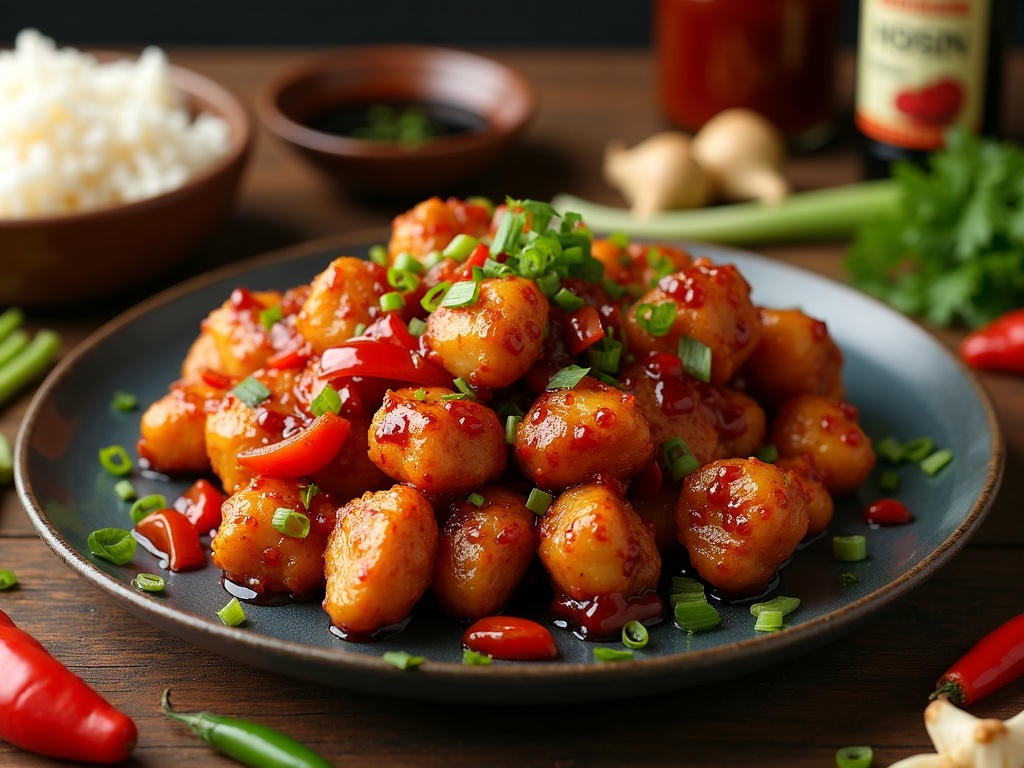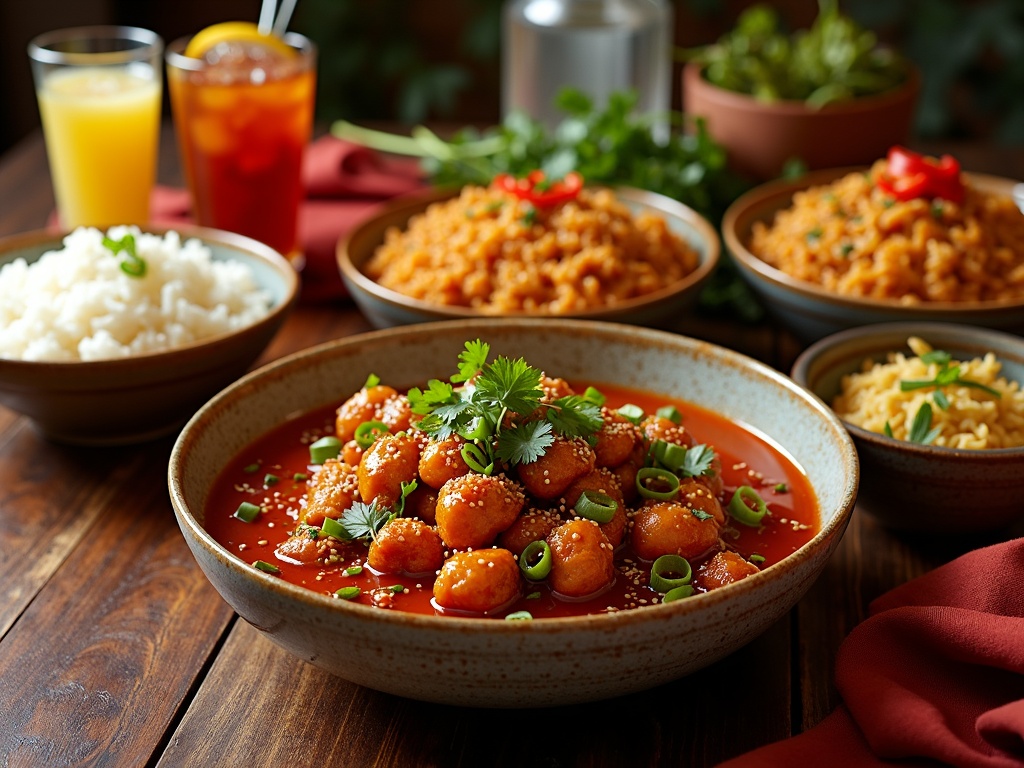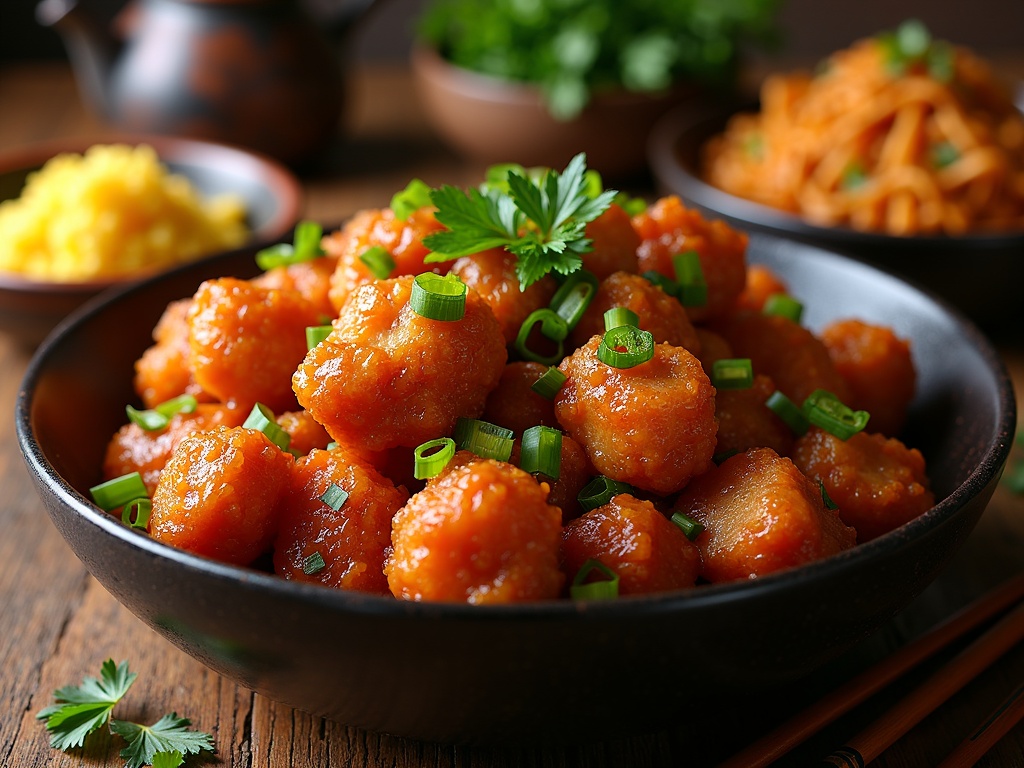Chicken Manchurian showcases the perfect fusion of Chinese cooking methods with Indian flavor profiles. It emerged when Chinese immigrants adapted their recipes in early 20th century India. This iconic Indo-Chinese dish features crispy fried chicken balls in a tangy, spicy sauce that has grown from necessity into a central element of fusion cuisine, now worth about $1.5 billion in India’s food market.
Find In This Article
Key Takeaways
- Chicken Manchurian originated when Chinese immigrants in Kolkata adapted their traditional recipes to suit Indian tastes, creating a distinct culinary tradition.
- The dish is available in three styles: dry (appetizer), semi-dry (balanced), and gravy (ideal for pairing with rice or noodles).
- Core ingredients include boneless chicken, soy sauce, fresh ginger, garlic, green chilies, and cornstarch for the signature crispy texture.
- Regional variations exist across India, with Bangalore versions being spicier while Delhi preparations tend to be sweeter and milder.
- For perfect presentation, garnish with fresh scallions, cilantro, and sesame seeds, and pair with Chinese fried rice or chow mein for a complete meal.
The Story Behind This Popular Indo-Chinese Dish
Chicken Manchurian has become an iconic dish that perfectly showcases the beautiful marriage between Chinese cooking techniques and Indian flavors. This delicious creation has a fascinating history that dates back to the early 20th century when Chinese immigrants settled in India and began adapting their traditional recipes to suit local tastes.
Origins and Cultural Fusion
The story begins with Chinese immigrants who made India their home and needed to adapt their cuisine to local preferences. These immigrants, primarily settling in Kolkata (formerly Calcutta), found themselves creating innovative dishes that would appeal to Indian palates while maintaining their Chinese cooking heritage.
What makes chilli chicken variants like Manchurian so special is how they balance Chinese cooking methods with Indian spice profiles. The deep-fried chicken balls coated in a tangy, spicy sauce represent a perfect example of culinary adaptation. Unlike traditional Chinese cuisine, Chicken Manchurian incorporates bold spices and heat levels that cater specifically to Indian taste preferences.
This cultural fusion created something entirely new – a cuisine that’s neither purely Chinese nor purely Indian. The preparation techniques remain Chinese, but the flavor profile has been significantly influenced by Indian culinary traditions. This innovative approach transformed simple dishes into something extraordinary that resonated with local diners.
Evolution and Popularity
From its humble beginnings, Chicken Manchurian has evolved to become a cornerstone of Indo-Chinese cuisine. As of 2023, the Indian-Chinese cuisine market contributes approximately $1.5 billion to India’s food industry, highlighting just how popular these fusion dishes have become.
I’ve noticed that Chicken Manchurian has transcended its restaurant origins to become a beloved staple in Indian households. Many families have their own special versions, some leaning more toward a garlic chicken flavor profile, while others focus on the sweet and tangy aspects of the sauce.
What started as a necessity for adaptation has transformed into a celebrated culinary tradition. Today, you’ll find Chicken Manchurian served alongside other Indo-Chinese favorites like:
- Chicken chow mein with its stir-fried noodles and vegetables
- Chinese fried rice infused with Indian spices and aromatics
- Gobi Manchurian, the vegetarian counterpart using cauliflower instead of chicken
- Spring rolls filled with spiced vegetable or meat fillings
The versatility of Manchurian sauce itself has led to countless variations. Some versions incorporate hoisin sauce for added complexity, while others focus on the garlic-soy combination that gives the dish its signature flavor.
The dish’s evolution continues today as modern chefs experiment with new interpretations while respecting its fusion roots. From street food vendors to five-star hotels, Chicken Manchurian has secured its place in Indian culinary culture. Its ability to satisfy cravings for something both familiar and exotic explains why it remains popular decades after its creation.
What makes this story particularly interesting is how a dish created out of necessity has become a source of culinary pride. Chicken Manchurian represents the beautiful things that can happen when cultures blend and adapt, creating something greater than the sum of its parts. As this culinary tradition continues to evolve, it stands as a delicious testament to cultural exchange and innovation.
Essential Ingredients and Nutrition Facts
Creating the perfect chicken manchurian requires a careful balance of ingredients that deliver its signature sweet, spicy, and tangy flavor profile. I’ve found that using high-quality ingredients makes a significant difference in the final dish.
Core Ingredients
The foundation of chicken manchurian starts with boneless chicken pieces that are marinated, coated, and fried until crispy before being tossed in a flavorful sauce. The sauce is what gives this dish its distinctive taste.
For authentic chicken manchurian, you’ll need:
- Boneless chicken pieces (preferably thighs for more flavor)
- Soy sauce (dark and light varieties work well)
- Fresh ginger and garlic (finely minced for maximum flavor)
- Green chilies (adjust according to your spice tolerance)
- Bell peppers (red and green for color and sweetness)
- Scallions (both white and green parts serve different purposes)
- Cornstarch (for coating the chicken and thickening the sauce)
The sauce components are equally important, combining soy sauce, vinegar, tomato ketchup, and various spices. Some chefs add a touch of hoisin sauce for depth of flavor, which pairs beautifully with the chicken.
For those looking to add more complexity, Sichuan pepper provides a unique numbing sensation that contrasts nicely with the heat from green chilies. This combination creates a flavor profile similar to chilli chicken, though manchurian has its own distinct character.
Nutritional Information
A typical serving of chicken manchurian (200-250g) contains approximately:
- 300-400 calories
- 15-20g protein
- 20-25g fat
- 15-20g carbohydrates
The protein content makes this dish particularly satisfying, while the moderate carbohydrate level means it pairs well with Chinese fried rice for a complete meal. The fat content comes primarily from the frying process, which can be reduced by opting for shallow frying rather than deep frying.
For those monitoring sodium intake, be aware that soy sauce contributes significant salt to this dish. I recommend using low-sodium options if sodium consumption is a concern.
Vegetarians need not miss out on this flavorful dish. Tofu or paneer make excellent substitutions for chicken, absorbing the rich flavors of the sauce while providing protein. The cooking technique remains similar, though the frying time will typically be shorter for these alternatives.
For a healthier spin on traditional chicken manchurian, consider garlic chicken techniques where the chicken is stir-fried rather than deep-fried, cutting down on oil while maintaining flavor.
The versatility of chicken manchurian means it can be adjusted to suit different dietary preferences. Adding more vegetables increases the fiber content, while reducing the amount of cornstarch creates a lighter sauce.
For a complete meal experience, chicken manchurian pairs wonderfully with chicken chow mein or steamed rice, creating a balanced plate with protein, carbohydrates, and vegetables.
Understanding these key ingredients and nutritional aspects helps you craft a delicious chicken manchurian that satisfies both your taste buds and nutritional goals.

Mastering the Cooking Process
The key to exceptional Chicken Manchurian lies in getting each step right, from marination to the final stir-fry. I’ve found that paying attention to these details transforms this dish from good to unforgettable.
Perfect Marination and Frying Technique
I always start with proper marination – coating bite-sized chicken pieces in a mixture of cornstarch and beaten egg creates that signature crispy exterior while keeping the meat juicy inside. For best results, I let the chicken marinate for at least 30 minutes, allowing the cornstarch to bond with the meat. This creates that authentic texture that chilli chicken lovers appreciate.
When deep-frying, I maintain oil temperature around 350°F (175°C). Too hot, and the outside burns before the inside cooks; too cool, and the chicken absorbs excess oil. I fry in small batches until each piece turns golden brown – usually 3-4 minutes per batch. This creates that perfect crunch that contrasts beautifully with the sauce.
The sauce is the heart of garlic chicken dishes like this one. I follow a precise ratio: 2 tablespoons soy sauce, 1 tablespoon vinegar, and 2 tablespoons ketchup. This balance delivers that tangy-sweet flavor that makes Manchurian dishes so addictive.
For the stir-frying phase, I use high heat and work quickly. The traditional method calls for adding the sauce to the wok first, letting it bubble slightly before tossing in the fried chicken pieces. This preserves the crispiness of the chicken while allowing it to absorb the sauce flavors.
The vegetables – typically bell peppers, onions, and spring onions – go in last and cook briefly. Unlike chicken chow mein, where vegetables might cook longer, Manchurian demands crunchiness in the vegetables for textural contrast.
I’ve found that quick cooking maintains the freshness of all ingredients, especially the garlic and ginger that form the aromatic base of the dish. From start to finish, the actual stir-frying takes just 3-5 minutes, making this dish almost as quick to prepare as Chinese fried rice.
For an extra flavor boost, I sometimes add a spoonful of hoisin sauce to the mix, giving depth to the sauce without overpowering the dish’s signature taste. The final product should have chicken pieces that maintain some crispiness while being coated in a glossy, flavorful sauce with bright, crunchy vegetables.

Regional Styles and Restaurant Variations
The popularity of Chicken Manchurian has led to fascinating regional adaptations across different cities, each with its own signature twist. I’ve noticed that this Indo-Chinese favorite comes in several preparations to suit different preferences.
Preparation Styles
Chicken Manchurian is incredibly versatile, available in three distinct forms to match your mood and meal requirements. The dry version features crispy chicken chunks coated with a thick, clinging sauce—perfect as an appetizer or snack. Semi-dry variations strike a balance with just enough sauce to keep the dish moist while maintaining some crispness. For a more substantial meal, gravy versions come with abundant sauce that pairs wonderfully with Chinese fried rice or noodles.
The regional differences are striking when you travel across India. Bangalore’s version packs significantly more heat than what you’ll find in Delhi, with extra chilies and peppercorns giving it a fiery kick. Delhi’s interpretation tends to be slightly sweeter and milder, often incorporating more hoisin sauce for depth of flavor.
Creative Variations
Restaurants have gotten creative with their Manchurian offerings, adding unique twists to stand out from competitors. Some upscale establishments sprinkle crushed peanuts or toasted sesame seeds on top, adding texture and nutty flavor that complements the garlic chicken notes in the dish. These additions have become signature elements in certain restaurants.
For vegetarians, Paneer Manchurian serves as an excellent alternative, using firm cottage cheese instead of chicken. The paneer absorbs the flavors beautifully while maintaining its texture, making it nearly as popular as the original chicken version. I’ve found that paneer works particularly well in the semi-dry style, similar to chilli chicken preparations.
Local spice preferences dramatically influence regional variations. Coastal areas often incorporate more ginger and garlic, while northern regions might add warming spices like star anise. Eastern variations sometimes include mustard oil for pungency, creating a flavor profile that’s distinctly different from western India’s sweeter, tangier interpretations.
For a complete Indo-Chinese meal experience, I recommend pairing regional Manchurian variations with other classics like chicken chow mein that complements the flavors perfectly.
Perfect Pairings and Presentation
I’ve found that chicken manchurian truly shines when served with the right accompaniments and proper presentation. This Indo-Chinese favorite transforms from a simple dish to a memorable meal when paired thoughtfully and presented with care.
Complementary Side Dishes
Chicken manchurian works brilliantly with a variety of carbohydrate bases that help balance its robust flavors. I recommend serving it over steamed rice for a clean canvas that soaks up the savory sauce beautifully. For something more flavorful, Chinese fried rice creates a perfect harmony with its subtle seasonings complementing the bold manchurian sauce.
Noodles offer another excellent pairing option. The combination of chicken manchurian with chicken chow mein creates a textural contrast that elevates both dishes. The slippery noodles coated in a light sauce balance the thick, rich manchurian gravy perfectly.
The side dish you select significantly influences the overall flavor experience. If you’re serving chicken manchurian with a heavily seasoned side like garlic chicken, consider toning down the intensity of your manchurian sauce slightly to prevent flavor competition.
Garnishing for Impact
The final presentation of chicken manchurian benefits tremendously from thoughtful garnishing. I apply these finishing touches just before serving:
- Fresh chopped scallions (2 tablespoons) for a mild onion flavor and vibrant green color
- Cilantro leaves (1 tablespoon) to add freshness and aromatic appeal
- Toasted sesame seeds (1 teaspoon) for nutty notes and textural contrast
- Thinly sliced red chilies (optional) for color and additional heat if desired
These garnishes aren’t merely decorative—they add crucial flavor dimensions. The scallions provide a subtle bite while cilantro brings freshness that cuts through the rich sauce. Sesame seeds contribute a pleasant textural element and subtle nutty flavor that complements the hoisin or soy-based notes in many manchurian recipes.
I’ve found that precise garnish measurements matter for balanced presentation. Too many scallions can overpower, while too few won’t provide enough fresh contrast to the cooked dish.
Beverage Pairings
Chicken manchurian’s bold flavors call for beverages that can refresh the palate between bites. I’ve found these drinks work exceptionally well:
- Lemon soda provides brightness that cuts through the richness
- Lassi offers a cooling effect that tempers the spice
- Iced jasmine tea cleanses the palate with its subtle floral notes
- Still or sparkling water with a squeeze of lime keeps things simple yet effective
Sweet beverages typically clash with the savory-spicy profile of chilli chicken dishes like manchurian, so I avoid them.
When hosting a dinner, I create a complete experience by coordinating the presentation of all elements. The manchurian takes center stage in a large serving bowl with its garnishes, surrounded by smaller dishes of complementary sides. This family-style service encourages sharing and allows guests to customize their plates.
The visual appeal of deep red-brown manchurian sauce against fresh green garnishes creates an appetizing color contrast that excites diners before they’ve taken their first bite. This thoughtful presentation transforms a casual weeknight dinner into something special.

Sources:
Food & Drink Magazine, The Evolution of Indian-Chinese Cuisine
Journal of Culinary Nutrition, Nutritional Analysis of Popular Indian Dishes
Indian Cooking Chronicles, Chicken Manchurian: Origins and Variants

